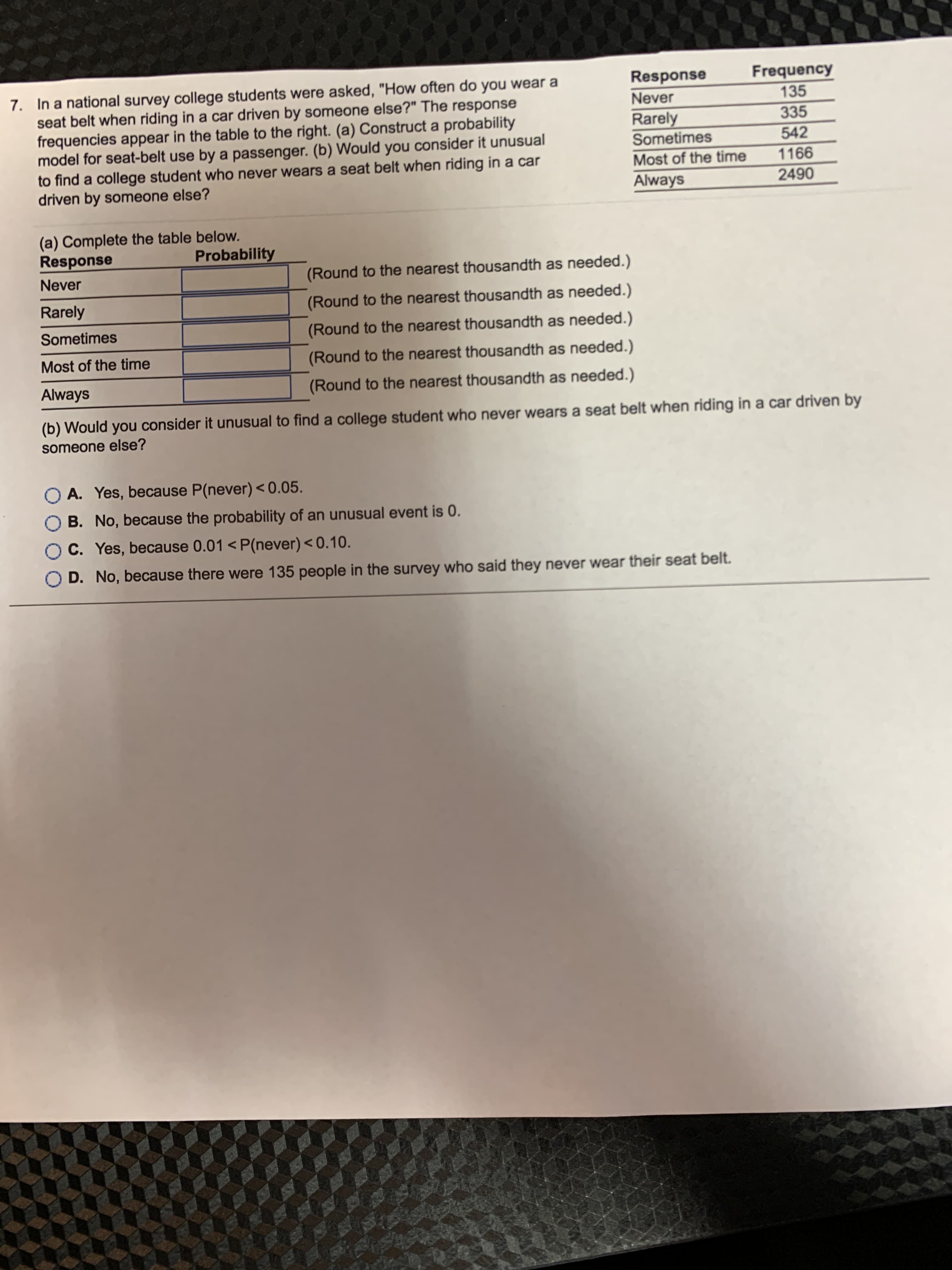Response 7. In a national survey college students were asked, "How often do you wear a seat belt when riding in a car driven by someone else?" The response frequencies appear in the table to the right. (a) Construct a probability model for seat-belt use by a passenger. (b) Would you consider it unusual to find a college student who never wears a seat belt when riding in a car driven by someone else? 135 Kɔuenba Never Rarely 335 Sometimes 542 Most of the time 991 Always (a) Complete the table below. Response Probability Never (Round to the nearest thousandth as needed.) Rarely (Round to the nearest thousandth as needed Sometimes (Round to the nearest thousandth as needed.) Most of the time (Round to the nearest thousandth as needed.) Always (Round to the nearest thousandth as needed.) (b) Would you consider it unusual to find a college student who never wears a seat belt when riding in a car driven by someone else? O A. Yes, because P(never)< 0.05. O B. No, because the probability of an unusual event is 0. O C. Yes, because 0.01 < P(never) < 0.10. D. No, because there were 135 people in the survey who said they never wear their seat belt.
Response 7. In a national survey college students were asked, "How often do you wear a seat belt when riding in a car driven by someone else?" The response frequencies appear in the table to the right. (a) Construct a probability model for seat-belt use by a passenger. (b) Would you consider it unusual to find a college student who never wears a seat belt when riding in a car driven by someone else? 135 Kɔuenba Never Rarely 335 Sometimes 542 Most of the time 991 Always (a) Complete the table below. Response Probability Never (Round to the nearest thousandth as needed.) Rarely (Round to the nearest thousandth as needed Sometimes (Round to the nearest thousandth as needed.) Most of the time (Round to the nearest thousandth as needed.) Always (Round to the nearest thousandth as needed.) (b) Would you consider it unusual to find a college student who never wears a seat belt when riding in a car driven by someone else? O A. Yes, because P(never)< 0.05. O B. No, because the probability of an unusual event is 0. O C. Yes, because 0.01 < P(never) < 0.10. D. No, because there were 135 people in the survey who said they never wear their seat belt.
Chapter8: Sequences, Series,and Probability
Section8.7: Probability
Problem 50E: Flexible Work Hours In a recent survey, people were asked whether they would prefer to work flexible...
Related questions
Question

Transcribed Image Text:Response
7. In a national survey college students were asked, "How often do you wear a
seat belt when riding in a car driven by someone else?" The response
frequencies appear in the table to the right. (a) Construct a probability
model for seat-belt use by a passenger. (b) Would you consider it unusual
to find a college student who never wears a seat belt when riding in a car
driven by someone else?
135
Kɔuenba
Never
Rarely
335
Sometimes
542
Most of the time
991
Always
(a) Complete the table below.
Response
Probability
Never
(Round to the nearest thousandth as needed.)
Rarely
(Round to the nearest thousandth as needed
Sometimes
(Round to the nearest thousandth as needed.)
Most of the time
(Round to the nearest thousandth as needed.)
Always
(Round to the nearest thousandth as needed.)
(b) Would you consider it unusual to find a college student who never wears a seat belt when riding in a car driven by
someone else?
O A. Yes, because P(never)< 0.05.
O B. No, because the probability of an unusual event is 0.
O C. Yes, because 0.01 < P(never) < 0.10.
D. No, because there were 135 people in the survey who said they never wear their seat belt.
Expert Solution
This question has been solved!
Explore an expertly crafted, step-by-step solution for a thorough understanding of key concepts.
This is a popular solution!
Trending now
This is a popular solution!
Step by step
Solved in 2 steps with 1 images

Recommended textbooks for you


College Algebra
Algebra
ISBN:
9781305115545
Author:
James Stewart, Lothar Redlin, Saleem Watson
Publisher:
Cengage Learning


College Algebra
Algebra
ISBN:
9781305115545
Author:
James Stewart, Lothar Redlin, Saleem Watson
Publisher:
Cengage Learning